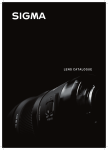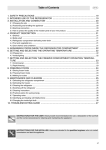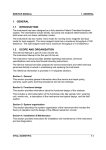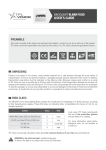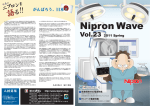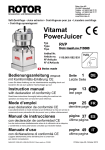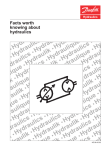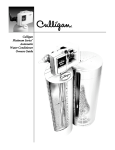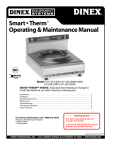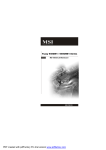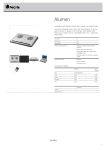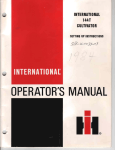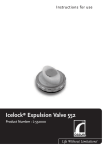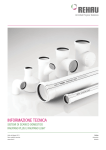Download Jumbo Bin User Manual - Mpact Plastic Containers
Transcript
JUMBO I N S OWNERS MANUAL CONTENTS Section Page Introduction 1 2 Bin Usage 2 4 Transportation 3 5 Storage 4 10 Handling Equipment 5 12 Packing House Equipment 6 14 Bin Identification 7 15 Maintenance 8 16 Hot Air Welder Repairs 9 18 Contact Details 10 23 Appendix 1 24 Appendix 2 25 1 SECTION 1 INTRODUCTION High pressure injection-moulded Jumbo Bins have been designed specifically to overcome the many shortcomings of wood bins and other forms of previously available plastic bins, such as those made from low pressure mouldings, such as rotationally cast bins and structural foam bins. Jumbo Bins are moulded from Polypropylene (PP). To achieve the maximum benefit from the use of the Jumbo Bins®, it is important to recognise the differences between plastic and wood bins and to handle and utilize the bins accordingly. A simple training programme, prior to the use of plastic bins, for those employees who directly handle your bins, such as forklift drivers and field supervisors, is strongly advised in order to enjoy to the maximum, the benefits offered by the Jumbo Bin. This guide will review important issues in the use of plastic bins. The information is current as of date of publication but is subject to change. Any further questions can be directed to: Mpact Plastic Containers at (021) 573 9400 SPECIAL ATTENTION SHOULD BE GIVEN TO THE FOLLOWING SECTIONS: 3. Transportation (Especially the way the bins are tied down on a truck) 4. Storage (Especially when empty) 5. Handling equipment (Forklift handling) 6. Packing house equipment (Especially bin tippers, stackers and de-stackers) 2 3 SECTION 2 BIN USAGE The Jumbo Bin has been designed specifically for the harvesting, processing and storage of fruit, vegetables and other types of agricultural products. All Jumbo Bins are manufactured from FDA (Food and Drug Administration) regulated foodapproved materials. It is important that Jumbo Bins are used in accordance with the design specifications, which are outlined in the Product Specification Sheets (see appendix 1). It is important to check the compatibility of PP to prolonged exposure to certain chemicals. A Chemical Resistance Chart has been prepared by CMOSA for use in determining the suitability in use of Jumbo Bins for certain applications. In general, the following must be observed: • Heavy objects should not be dropped onto the floor of the bin as they could damage the floor. • Holes should not be drilled in Jumbo bins, as any modifications to bins will void the warranty. • Jumbo Bins must not be stacked when the corner post section of the bin has been damaged. • Jumbo Bins must not be pushed off trucks onto concrete or other hard surfaces. • Jumbo Bins should be periodically inspected for structural damage to the corner posts and upper ribs. This is very important in applications where bins are stacked, as the corner posts have been designed to bear most of the load when the bins are stored in a stack. • Any major cuts or cracks to the corner posts may cause structural collapse in a stack. Based on this inspection, bins should then be sent in for recycling or repaired. Bins with repaired corner posts should be used only in non-stacking applications. • Do not interstack wood bins with Jumbo Bins. 4 SECTION 3 TRANSPORTATION Jumbo Bins are much lighter than wood bins and because the feet interlock, they form a more stable block when tied together on a truck and trailer. The plastic material they are made from is smoother than wood so they tend to slide more in transport. Provisions must be made to prevent bins from sliding backward and forward as well as for sliding from side to side. A. Bin Movement – Forward/Backward The force of the wind hitting the front stack of bins tends to force the load on a trailer to the rear possibly forcing the last row of bins at the rear of the trailer off the back. A quick stop may also cause the bins to slide forward. Strapping may not be sufficient to effectively control this problem and it is recommended that the following be done in addition to strapping down: o Weld stops on the front and rear of all trailers to prevent bins from sliding forward or back. o The addition of an approved bulkhead wall at the front of the trailer to prevent forward movement of the load would be advisable as a safety provision if a wall is not already in place. o In the absence of these provisions it is recommended that pillars be used in place of the welded stops. Pillars should be placed at the front and rear ends of the trailer. 5 B. Bin Movement from Side to Side As trailers are pulled down the highway they can sway from side to side creating the potential for side-drift of the bins. Hard cornering and high winds further contribute to this problem increasing the probability of side drift. To prevent this problem, the following is recommended: Effective cross-tying with ropes or straps will prevent bins from moving in any direction. Optimum results are achieved with straps and winches but suitable rope can be used in cases where trailers are not equipped with winches. Cross-tying of wood bins is done by running the strap or rope across the centre of each bin. This is not recommended with Jumbo Bins as the centre post is not designed for this type of force. As the strap or rope is tightened, the side walls will be forced inward and deformed. This deformation is not permanent, provided excessive force is avoided, and the bin will return to normal within 24 hours. Nevertheless, cross-tying in this manner is not recommended since it is difficult to control the force exerted and the procedure which follows is recommended: To avoid cross-tying of Jumbo Bins on the centre post, “V-boards” should be used to connect two bins at the upper corners, thereby bridging the space between them and creating a surface over which the rope or strap can be draped. This method is preferred since the greater strength of the corner posts are better able to sustain over-tensioning of the cross-tie. It also allows two stacks of bins to be safely secured using one Cross-tie. 6 C. Bin Loading on Trailers The following procedure should be adhered to when loading bins on to trailers: 1. On trailers without “stops” at the front and rear of the trailers, pillars should be put in place before loading. Pillars should be placed at both ends of each of the trailers. 2. Load the bins starting at the pillar end of the trailer with the first stacks placed tight up against the pillar. It is important to pack the load as tight as possible as the load will tend to settle together in the first few kilometers of travel, causing slack in the strapping. For this reason, it is imperative that the straps be checked for proper tension and tightened if needed after the first 10 kilometers of travel. 3. Place the “V-boards” on top, spanning 2 bins so that the strapping can be draped over the area between 2 stacks. Tie-down over “V-boards” placed across the corner columns of two stacks 7 4. The strapping should then be sufficiently tightened. The strap should not be as tight as is required with wood bins, but enough to securely hold down the load. Over-tightening the straps may cause deformation of the corner posts so care must be taken when tightening straps. For best results, straps and winches should be used to cross-tie but rope can be used when this is not possible. 5. After about 10 kilometers of travel on the road, the load must be checked to ensure that it is still secure, and if needed, the straps should be tightened again. The bins may shift and be forced closer together after being driven on the highway, causing slack on the straps. NOTE: It is imperative that tie-down methods implemented comply with local authority regulations governing bin hauling. It is the responsibility of the user to ensure they are in compliance with these regulations. This is a very important step and must not be neglected. D. Nesting Jumbo Bins can be transported on trucks or trailers in the normal manner or can be nested. Nesting enables three bins to be transported in the space of two. 8 Nesting Procedure The following procedure should be followed when nesting bins: Step 1. Nest a bin on its side and slide another bin into it as shown. Step 2. Right the 2 bins, keeping them nested together then lift a third bin upside down and place it over the lower 2 bins. A stack of 2 nested sets of bins can then easily be prepared for loading onto a flatbed trailer or for storage. Step 1 Step 2 Nested - 3 in the space of 2 Denesting Procedure is the reverse of the nesting procedure. 9 SECTION 4 STORAGE A. Outdoor Because Jumbo Bins incorporate a state-of-the-art ultra-violet (UV) stabiliser, outdoor storage is perfectly acceptable. B. Maximum Capacity and Stack Weight Limits Jumbo bins have been designed to perform within specific maximum load capacities and stacking tolerances. For capacity and stack weight limits for Jumbo Bins, please refer to Mpact Plastic Containers Jumbo Bin’s Product Specification Sheets. Appendix 1. C. Stack Height Empty When stacking more than 4 high, they should be stored in blocks of several stacks. This is to avoid the bins being blown over by high winds. General Rule: The higher the stack, the wider the block. As a safety precaution, when bins are stacked higher than 4 high, they should be located in an area away from personnel activity. As an extra precaution against high winds, diagonal cross-bracing, using the hand-held area to hold strapping hooks is advised. Diagonal cross-bracing 10 D. Interstacking It is essential to ensure that load stresses are transferred in the designed manner in a stack of bins. To achieve this, Jumbo Bins have been designed with a patented interlocking foot which ensures the proper bearing of loads. Under no circumstances must Jumbo Bins be interstacked with wood bins or other manufacturers’ plastic bins. It is imperative that bins are stacked with the foot sides lined up from the bottom to the top of the stack. E. Temperature Ranges The following temperature limits apply to Jumbo Bins: Polypropylene Low High -30ºC 77ºC Please refer to the product specification sheets for additional details on the use and stacking of Jumbo Bins at various temperature levels. Great care should be taken when using the Jumbo Bin at the high and low limit. Normal operating conditions for the Jumbo Bin are set at: Between 0ºC and 34ºC. 11 SECTION 5 HANDLING EQUIPMENT Forklift Handling Plastic bins are smoother than wood so they will slide on forks. When transporting Jumbo Bins on forklift trucks, travel in reverse with the forks tilted back. Attaching rubber or other non-skid material to the top of forklift forks will also help to prevent bins from sliding. Travel in reverse with forks titled back • Since Jumbo Bins are approximately 45% lighter than wood bins, it is imperative that forklift drivers take this into account when handling. A combination of the lighter weight and stacking capabilities creates a stack that, with careless handling on a forklift, is prone to tipping over. • Care must be taken when cornering and traveling over rough surfaces with empty bins as they can easily tip and be dropped. • To prevent a stack from falling when it starts to tip, the forks should be lowered so that the bottom bin feet slide along the ground and the forklift should be stopped. This will stabilise the stack so it can be lifted up and moved again. Under no circumstances should bins be moved by sliding them along the ground, as this will cause premature wear of the feet. 12 • The radiuses entry of Jumbo Bins permits considerable misjudgement of height on the part of the driver. It is thus inevitable that the radius will be frequently struck by the tips of the forks. TO REDUCE WEAR AND TEAR ON THE RADIUSED ENTRY OF JUMBO BINS, IT IS IMPORTANT THAT THE FORKLIFT TIPS ARE FREE FROM BURRS AND SHARP EDGES ON THEIR UPPER SURFACE. A little time spent on these areas will be generously repaid in longer bin life. Bin Trailers Most bin trailers require no modifications to handle Jumbo Bins. Modification is required when the tops of the rollers are below the level of the top of the frame. This may cause the bin foot to rest on the frame instead of the rollers, thus preventing the bin from easily rolling off the trailer. In such cases, the rollers must be raised to a point where the top of the roller clears the top of the frame. This will allow the bin to roll freely. Depending on the height, the rollers must be raised. This can be done by either: 1. Removing the rollers and adding a sleeve to increase the roller diameter. 2. Re-drilling the frame and raising each roller to clear the frame. 13 SECTION 6 PACKING HOUSE EQUIPMENT De-stackers Most de-stacking equipment will handle the Jumbo Bins with little or no major modifications. In some cases, it is advisable to cut a bevel into the leading edge of the lifting dog and to extend them slightly. This is necessary to accommodate the rounded forklift entry area of Jumbo Bins. It is also advisable to adjust the present guides or to add guides to insure that the bin is centered between the lifting dogs before being raised. The best way to test the compatibility of Jumbo Bins with your equipment is to fill some bins with product and run them through. If there are any problems, they will become obvious. Stackers As with de-stackers, most stacking equipment will run Jumbo Bins with little or no modifications. Running bins through the equipment will quickly bring out any problems. Floaters Jumbo Bins have easily run through all floaters that they have been tested in. Jumbo Bins have the added bonus of plastic construction allowing them to be immersed indefinitely with virtually no negative effects to the bin. Pre-Sizing Lines Jumbo Bins have been tested in a number of pre-sizing lines with no problems. Bin Tippers Bin tippers should be rotated 140 degrees from resting position to ensure the removal of all fruit from the bin. This may require some modification to some tippers. Pallet Jacks The Jumbo Bin is not designed to be used with standard hand pallet jacks when fully loaded. If this is required, it is recommended that low profile pallet jacks with a maximum collapsed height of 65mm are used. For further information, please contact your local sales representative. 14 SECTION 7 BIN IDENTIFICATION A variety of options are available for marking bins for identification. The following methods are currently used: 1. Foil Embossing: Foil embossing is the most attractive method available for the marking of Jumbo Bins. This requires a heated press which can apply a coloured logo to the recessed panels on the front and rear centre posts. Thus, it has to be done at the factory prior to delivery. A variety of colours are available. Foil embossed id tifi ti 2. Branding: An electrically heated cattle brand can also be purchased to brand the bin. The branding iron is heated and pressed into the bin leaving an indented mark. This method is effective but not as attractive as the foil embossing and must be done by the customer. 3. Label Holders: Jumbo Bins have been equipped with a label holder that will accommodate a card with a maximum size of 10 x 22 cm, eliminating the problems associated with staples on wooden bins. Elastic band 4. Painting: Label holder for bin tickets PP cannot be painted successfully. 15 SECTION 8 MAINTENANCE One of the major benefits of the Jumbo Bin is the lack of maintenance required to keep them in good condition, as compared with wood bins which require constant, expensive repairs. High pressure moulded PP is a tough, resilient material that will withstand a great deal of use, provided that they are not abused. Cleaning Bins can easily be cleaned using high pressure washers with fine spray and mild soap. Under no circumstances should steam cleaners be used to clean bins, as the high temperatures used will damage the bin. Foot Replacement Feet on the Jumbo Bins are replaceable. In the event of severe damage or extreme wear, the foot can be replaced either at the factory or by the user. Method of replacement is as follows:1. Care must be taken not to damage the bin body when removing a worn or damaged foot. 2. When fitting the replacement foot, it is important to ensure that the locking lugs are securely engaged before the bin is used. 16 Repair of Damaged Panels Panels can be repaired utilizing a hot air welder. The hot air welder can be used to repair cracked side panels and bottom panels but is not recommended for repair of major damage to the corner posts. Bins with major damage to the corner posts should either be sent back for recycling or repaired and limited to use in non-stacking applications. A hot air welding guide is included in this document in section 9. 17 SECTION 9 HOT AIR WELDING REPAIRS • Hot air welding of Polypropylene (PP) is a relatively easy process to learn. It shares only the name and a few technical characteristics with metal welding. Do not think in terms of metal welding when performing plastic welds as they require very different techniques. • The following guidelines on welding Jumbo Bin containers refer only to the welding of the eight flat panels on the sides of a Jumbo Bin. • Specifically excluded from welding or any repair if damaged are the four corner posts or the underside of the bin. • Furthermore, welding the Jumbo Bin, other than in accordance with this guide, may void its warranty. • It is exclusively the responsibility of the owner to ascertain and determine whether or not the structural integrity of the container will be affected in his application. • Mpact Plastic Containers Ltd encourages its customers to get as much value from their bins as possible. • One of the ways Mpact offers exceptional value is through a bin recycling programme. This option should be considered if the bin is badly damaged. Contact your sales person for details. • It is important that only food grade PP welding rod is used. Using non- food grade rod will preclude Mpact from recycling your bin. Mpact will ask you to certify that only food grade materials have been used to repair your bin. 18 WELDING EQUIPMENT To weld PP the following items are needed: 1. Hot air welder. 2. Welding or filler rod. 3. High Speed Welding Tip. 4. Small Paint scraper or equivalent. 5. “Sureform” shaver tool used to smooth rough Bondo on auto body work. 6. Side cutter pliers. Because welding requires a certain amount of skill, it is highly recommended that practice welds be performed on scrap plastic before welding the Jumbo Bin surface. 19 WELDING PROCEDURE 1. Clean the area to be welded. 2. Using the paint scraper or equivalent tool, cut a V-groove along the crack to be welded. This important step removes oxidized plastic that could inhibit welding. 3. Tack-weld pieces to be welded if needed. In most cases, this will not be necessary when welding panels. 4. Make sure correct Polypropylene rod is used. It will be white in colour. Other colour rods are for different materials and will not provide a proper weld. Cut a welding rod at a 60 degree angle to start the weld. 5. Start the welder by setting the temperature to 300 degrees C. (500 degrees F ). 6. Feed the cut end of the rod into the speed tip after warming the crack where you will start the weld. (Do not melt the plastic). 7. When the tip of the rod starts to become clear, place it onto the start of the crack in the bin. 8. Slowly pull the welder along the crack, feeding the rod with your other hand. 9. After about 3 cm of welding rod has been applied, let go of the rod. The rod will now feed automatically and both hands can be used to handle the welder until the weld is completed. 10. At the end of the weld, lift the welder and slide the remaining rod through the speed tip. 11. Turn the welder temperature to its lowest setting letting it run until the speed tip has cooled down. This is extremely important as the tip will become brittle and crack if the welder is shut off immediately. 20 12. When the weld has cooled, cut the excess rod and let the weld set for 30 minutes to cure before testing. 13. At this point the scraper can be used to smooth the welded surface. 14. For optimum results when repairing the bin side wall, this procedure should be repeated on the opposite side of the weld. USEFUL HINTS 1. The rod should keep its round shape as the weld is performed. Soften it until it merges with the base material. Do not mush or puddle it. 2. Welding rod should be cut to the length of the weld. Do not stretch the rod. 3. A properly performed weld is stronger than the base material. 4. Using solvents for cleaning may soften the edges and cause poor welds. 5. A good weld will have a fine bead along each side of the rod. 6. If the welder temperature is too hot or the welder is moved too slowly along the crack, the bead will be wide and irregular, resulting in a poor weld. 7. If the welder temperature is too low or the welder is moved too quickly along the crack, a bead will not form and a poor weld will result. 8. Use the following weld photographs to check your welds. 21 9. When damaged, the bin side panels are frequently buckled and hard to keep flat during the welding process. To keep the panels flat, a steel plate should be prepared with clearance holes for 10 mm bolts that will line up with the vents on the side panels. The plate should be located on the reverse side of the panel to be welded, locating the bolts in such a manner as to flatten the area around the crack. Use flat washers on bolts to flatten the plastic panel against the plate. This will flatten the area around the crack and create a solid base to more easily prepare and weld the crack. There are many hot air welders on the market. Mpact Plastic Containers recommends the HG 2000 E and the AGR 6000EL. The major advantages of the HG 2000 E are the ability to set the air temperature, speed welding tip, and its robust construction. The HG 2000 E can be purchased from: P M Distributors P O Box 1093 Kraaifontein 7569 Tel: (021) 987 2727 They will also provide technical assistance for any welding problems you experience. Make sure you specify Mpact approved welding rod when ordering. HG 2000 E Electronic Hot Air Gun (includes high speed welding tip): R896, 00 excl. VAT. The other items needed, can be purchased at any hardware store. Prices are given as a guide only and are subject to change without noticed. Please contact the Vendor for current pricing. 22 DISCLAIMER: MPACT PLASTIC CONTAINERS MAKES NO WARRANTY, EXPRESS OR IMPLIED, AS TO THE FOREGOING MODIFICATIONS, INCLUDING, WITHOUT LIMITATION, THEIR DESIGN, SUITABILITY OF FITNESS FOR ANY PARTICULAR PURPOSE, QUALITY OF MATERIAL OR WORKMANSHIP OR DURABILITY, AND HEREBY SPECIFICALLY DISCLAIMS ANY SUCH WARRANTY. WITHOUT LIMITING THE GENERALITY OF THE FOREGOING, MPACT PLASTIC CONTAINERS SHALL NOT BE LIABLE OR RESPONSIBLE FOR ANY DEFECTS, EITHER PATENT OF LATENT (WHETHER OR NOT DISCOVERABLE), IN ANY OF SUCH MODIFICATIONS OR THE MODIFIED EQUIPMENT, OR FOR ANY DIRECT OR INDIRECT DAMAGE TO PERSONS OR PROPERTY RESULTING THEREFROM, OR FOR INCIDENTAL OR CONSEQUENTIAL DAMAGES (INCLUDING STRICT OR ABSOLUTE LIABILITY IN TORT), OR FOR USER’S LOSS OF USE OF ANY OF THE MODIFIED EQUIPMENT OR FOR ANY INTERRUPTION IN USER’S BUSINESS CAUSED BY USER’S INABILITY TO USE ANY OF THE MODIFIED EQUIPMENT FOR ANY REASON WHATSOEVER. Section 10 Mpact Plastic Container Telephone: Fax: Street Address: Postal Address: Email Address: Website: (021) 573-9400 (021) 577-3399 Neil Hare Road, Atlantis 7349. P O Box 1551, Dassenberg 7350 [email protected] www.mpcsa.co.za 23 Appendix 1 24 Appendix 2 POLYPROPYLENE TECHNICAL INFORMATION TI-KTE / PN-15 D 81063 (769) MAY 1986 registered trademark RESISTANCE TO CHEMICALS Polypropylene’s re si stance to chem icals cov alent characteri sti cs of polypropylene. is determi ned by the Polypropylene i s resi stant to sev eral cov alent li qui ds includi ng alcohols, organi c aci ds, ethers and ketones. Swelli ng i s observ ed when Polypropylene com es i nto contact wi th aliphati c and arom ati c hydrocarbon and halogenated hydro carbon. Thi s impai rs the streng th. Once the li qui d causi ng the swelli ng has ev aporated, origi nal characteri sti cs are to a large extent rei nstalled. Polypropylene i s resi stant to hydrous so luti ons of i norgani c salts and to alm ost all i norgani c aci ds and al kali nes, whi ch i ncludes hi gh concentrati ons of the abov e at temperatures exceedi ng 60°C. Howev er, oxi di si ng substances e.g. chlorosulfonated aci d, oleum , concentrated ni tri c aci d and halogens affect Polypropylene ev en at am bi ent temperatures. It should be e mphasi sed that Polypropylene wi th speci al characteri sti cs (extracti on-stable hi gh-tem perature-resi stantstabi li sati on..11, thi rd fourth digi t i n the type desi gnati on) has an excellent re si stant to stand ard washi ng agents at tem peratures up to 100°C. No tensi on cracks i n Polypropylene caused by chem i cals hav e yet been observ ed. Polypropylene causes gases and ali phati c / arom ati c hydrocarbons wi th low boi li ng points and chlori nated hydrocarbons to di ffuse to a certai n extent. The results of v ari ous tests conducted wi th reference to DIN 53476 are summ ari sed i n the followi ng table. Results were determi ned by subj ecti ng com pressed test sam ples of 1mm thi ckness to the li sted substances under no-load condi ti ons for a peri od of 30 days. Results were taken i nto co nsi derati on i f experi ences ov er longer testi ng periods were av ailable. Changes i n wei ght after 30 days testi ng period wi th testi ng substances were determi ned followed by tensi le tests as per DIN 53455 wi th swol len sam ples to assess the resi stance. 25 Thi s table m ay only be used as a gui deli ne to determi ne the sui tabi li ty of formed parts m ade of Polypropylene because as resi stance to chemicals depends on the shape of the product and subsequent stress condi ti ons. In most cases fi eld tests are absolutely e ssenti al. Abbrev i ations used in the table: Cold sat. = cold saturated s = m easured v alue, Boili ng poi nt of test substance w = hydrous soluti on The followi ng symbols were used for the resi stance: + = resistance Negli gible swelli ng Irrelev ant changes i n yi eld stress ± = fairly resistant Sli ght swelli ng Reduced yi eld stress Under cri ti cal sui tabi li ty - condi ti ons, conduct tests and determi ned = non res istant Excessiv e swelli ng Consi derably im pai red yi eld stress Strai n or stre ss o v er a short period may be possi ble Missing symbols mean that in terms of stated conditions no tests were conducted. 26 SUBSTANCE CONCENTRATION % 20°C HOMOPOLYMER BLOCK COPOLYMER RANDOM COPOLYMER 60°C 100°C Chemicals Acetone Acrylonitrile Alumen, all types Allyl alcohol Aluminium salts Formic acid Formic acid Formic acid Formic acid Ammonia, liquid Ammonia, gaseous Ammonia Ammonia Ammonium acetate Ammonium carbonate Ammonium chloride Nitrate of ammonium Ammonium phosphate Ammonium sulphate Amyl alcohol Aniline Anisole Barium salts Benzaldehyde Benzaldehyde Benzoic acid Benzoic acid Benzene Benzyl alcohol Succinic acid Borax Boric acid Boric acid Bromine, liquid Bromine vapours Bromine vapours Bromine water Hydrobromic acid Butane, liquid Butane, gaseous 1,4-butane diol butane diol n-butanol butyl glycol 100 100 w.any w.96 w.any w.98 w.85 w.50 w.10 100 100 w.30 w.10 w.any w.any w.any w.any w.any w.any 100 100 100 + + + + + + + + + + + + + + + + + + + + + ± +(s) w.any 100 w.cold saturated 100 w.cold saturated 100 100 w.cold saturated w.cold saturated 100 w.cold saturated 100 high low cold saturated 50 100 100 100 100 100 100 + + + + + ± + + + + + ± + + + + + + + + + + + ± ± ± + + + + + + + + + + + + + + ± + + + + + + + + + + + - + + + 27 SUBSTANCE CONCENTRATION % calcium carbonate calcium chloride chlorinated lime calcium nitrate chlorine, liquids chlorine, gaseous, humid chlorine,gaseous,dry chlorobenzene chloroacetic acid chloroform chlorosulphonic acid chlorine water hydrogen chloride, gaseous chromous salts (bivalent and trivalent) chromium trioxide (chromic acid) chromium trioxide w.cold saturated w.cold saturated w.any w.cold saturated 100 10 HOMOPOLYMER BLOCK COPOLYMER RANDOM COPOLYMER 20°C 60°C 100°C + + + + ± ± + ± ± + + + + w.cold saturated + - w.20 + ± cyclo hexane cyclo hexanol cyclo hexanone 100 100 100 ± + + ± - decahydronaphthalen e diethyl ether dispropyl ether dimethyl formamide 1,4-dioxan 100 100 100 100 100 ± ± ± + ± ± - w.cold saturated 100 + + + ± + - w.10 w.50 100 100 100 + + ± + ± + + - + 100 ± ± ferrous salts acetic acid (crystallisable acetic acid) acetic acid acetic acid acetic acidamyl acetate acetic anyhyride acetic butyl ether (butyl acetate) ethyl acetate (acetic ether) 100 100 100 100 100 cold saturated any w.cold saturated + + + + + + - - - 28 SUBSTANCE CONCENTRATION % HOMOPOLYMER BLOCK COPOLYMER RANDOM COPOLYMER 20°C 60°C 100°C methyl acetate ethyl alcohol ethyl alcohol ethyl alcohol ethyl alcohol ethyl benzene ethyl chloride ethylene chloride 2-ethyl hexanol 100 100 w.96 w.50 w.10 100 100 100 100 + + + + + ± -(s) ± + +(s) hydrofluoric acid formaldehyde formaldehyde formaldehyde fructose 40 w.40 w.30 w.10 w.cold saturated + + + + + + + + + + + glucose glycerin glycerin glycols glycols w.cold saturated 100 w.any 100 w.any + + + + + + + + + + + + + + + carbamide n-heptane n-hexane w.cold saturated 100 100 + ± ± + ± ± 100 100 ± + ± + 50 25 10 w.cold saturated + + + + + + + + w.cold saturated w.cold saturated w.cold saturated w.cold saturated w.cold saturated w.cold saturated + + + + + + + + + + + + w.cold saturated w.cold saturated w.cold saturated 100 w.cold saturated + + + + + + + + ± + isooctane isopropyl alcohol caustic potash solution caustic potash solution caustic potash solution potassium carbonate (potsh) potassium chlorate potassium chloride potassium dichromat potassium iodate potassium nitrate potassium permanganate potassium persulphate potassium sulphate cresylic acid crysylic acid cuprous salts + + + - + + 29 SUBSTANCE CONCENTRATION % HOMOPOLYMER BLOCK COPOLYMER RANDOM COPOLYMER 20°C 60°C 100°C magnesium salts menthol methyl alcohol (methanol) methyl alcohol methylic chloride methyl ethyl ketone lactric acid lactric acid lactric acid morpholine w. cold saturated 100 100 + + + + + w.50 100 100 w.90 w.50 w.10 100 + ± + + + + + ± + + + + naphthalene sodium acetate sodium bisulphite sodium carbonate sodium carbonate sodium chlorate sodium chloride (table salt) sodium hydrogen carbonate (bicarbonate) sodium hydroxide (caustic soda) sodium hypochlorite sodium nitrate sodium nitrite sodium perborate sodium phosphate sodium sulphate sodium sulphide sodium sulphite sodium thiosulphate (fixing salt) caustic soda lye caustic soda lye caustic soda lye nickelsalts nitrobenzene 100 w.cold saturated w.cold saturated w.cold saturated w.10 w.25 w.cold saturated + + + + + + + + + + + + + + w.5 w.cold saturated + + + + 100 + + w.13 w.cold saturated w.cold saturated w.cold saturated w.cold saturated w.cold saturated w.cold saturated w.cold saturated w.cold saturated + + + + + + + + + + + + + + + + + 50 25 10 w.cold saturated 100 + + + + + + + + + ± oleic acid oxalic acid ozone (0,5 ppm) 100 w.cold saturated + + + ± ± +(s) + + + + + + + + 30 SUBSTANCE tetrachloroethylene s. tetrachloroethylene phenol phenol phosphorous oxychloride phosphorous pentoxide phosphoric acid phosphoric acid phosphoric acid phosphorous trichloride phthalic acid propane, liquid propane, gaseous propionic acid propylene dycols pyridine CONCENTRATION % HOMOPOLYMER BLOCK COPOLYMER RANDOM COPOLYMER 20°C 60°C 100°C 100 w. cold saturated 100 + + + 100 85 50 10 100 w.50 100 100 w.50 100 100 + + + + + + + + + + ± + + + ± mercury mercury salts 100 w.cold saturated + + + + nitric acid nitric acid nitric acid nitric acid hydrochloric acid hydrochloric acid sulphur sulphur dioxide carbon bisulphide sulphuric acid sulphuric acid sulphuric acid sulphuric acid hydrogen sulphide silver salt stearic acid 68 50 25 10 36 10 100 any 100 98 85 50 10 w. low w.cold saturated 100 ± + + + + + + ± ± + + + + + + ± + + + + + 100 100 ± ± 100 100 100 100 100 100 ± ± ± ± tetrachloroethane tetrachloroethylene (perchloroethylene) carbon tetrachloride tetrahydrofurane tetrahydronaphthalen e thiophene toluol + + ± + + + + + ± + + + + + + - 31 trichloroethylene SUBSTANCE water hydrogen peroxide hydrogen peroxide hydrogen peroxide tartaric acid xylene zinc salts tin (ii)-chloride citric acid ± CONCENTRATION % 100 30 10 3 w. cold saturated + + + + + + ± + + + 100 ± - w.cold saturated w.cold saturated w.cold saturated + + + + + + + + + + + ± ± ± ± ± + + ± ± + + ± + + + + - + Consumer goods (technical) pharmaceutics, cosmetics acronal-dispersion battery acid asphalt * aspirin straight-run gasoline mineral turpentine gasoline, normal gasoline, super beeswax bleaching lye (12,5% active chlorine) floor polish * brake fluid * chloride of lime (hydrous slurry) chrome baths, techn. * chromosulphuric acid dextrin diesel oil HOMOPOLYMER BLOCK COPOLYMER RANDOM COPOLYMER 20°C 60°C 100°C w. cold saturated fatty alcohol sulphonate fir leaf oil + + ± + + + * Resistance depends on the composition 32 SUBSTANCE fixing salt CONCENTRATION % any HOMOPOLYMER BLOCK COPOLYMER RANDOM COPOLYMER 20°C 60°C 100°C + Frigen 113 - antifreeze (motor vehicles) + dishwashing liquid * + + + + standard + ready-made + + shampoo * + + heavy (heating) fuel * ± ± tincture of iodine + kerosene ± ± fir leaf oil + + bone oil + + nitrohydrochloric acid ± - Lanolin (wool fat) + ± Linseed oil + + Lysol + ± mineral oils (without aromatic compounds) * + ± - + ± - + ± nail varnish * + ± nail varnish remover * + ± furniture polish * engine oils (motor vehicles) * oleum any - - paraffin + + - paraffin oil + ± - perfume + petroleum ether ± ± petroleum ± ± standard + + ready-made + + photographic developer * Resistance depends on the composition 33 SUBSTANCE CONCENTRATION % HOMOPOLYMER BLOCK COPOLYMER RANDOM COPOLYMER 20°C 60°C 100°C sagrotan + ± soft soap + + shoe polish * + ± soap, soap bars + + soap suds + + silicone oils * + + tar * + ± turpentine ± - ink + + transformer oil * + ± vaseline + ± washing powder standard ready-made + + + + water glass softener + + dibutylphthalate (Palatinol c) + disononylphthalate (Palatinol dn) dioctyladipate (Plastomoll doa) + dioctylphthalate (Palatinol AH) + tricresylphosphate + trioctylphsophate + toothpaste Food and drinks + + pineapple juice + + apple sauce + + apple juice + + orange juice + + orange peel + orange peel oil + beer + bitter almond essence + butter + buttermilk + + + + + * Resistance depends on the composition 34 SUBSTANCE CONCENTRATION % HOMOPOLYMER BLOCK COPOLYMER RANDOM COPOLYMER 20°c 60°c 100°c cola drinks + peanut oil + + + + pickled fish + + fruit juices + + + + jelly + + + vegetable + + + gin + grape juice + vinegar gelatin yeast standard w. any w.any ± + + + honey + cheese + coffee (beans and ground) + coffee, instant + cocoa, powder + cocoa, instant + + + + + + mashed potatoes + + potato salad + coconut oil + + cake cod liver oil liqueurs + + + + any + lemonades + maize oil + liqueurs + lemonades maize oil + ± margarine + + jam + + + mayonnaise + horse radish, ready to serve + flour + milk + + + dishes containing milk + + + mineral water + + + 35 SUBSTANCE CONCENTRATION % HOMOPOLYMER BLOCK COPOLYMER RANDOM COPOLYMER 20°C 60°C 100°C gloves (spice) + oil of gloves + fruit salad + olive oil + + palm kernel oil + ± red pepper (spice) + pectin w.cold saturated + ± + pepper + peppermint oil + pudding + cream cheese + beef suet + + rum + + rum essence + cream, whipped cream + salt, dry + pickled herrings + + + + + + + + pickled white cabbage + + + ready-to-serve lard + + ± mustard + soda water + soya oil + ± salad oil (vegetable) + ± salad oil (animal) + ± brine starch, starch solution any w. any + tea, instant + + tea leaves + + tomato sauce + + tomato juice + + vanilla + wine, punch + brandy + whisky + sausage + + + + 36 SUBSTANCE CONCENTRATION % HOMOPOLYMER BLOCK COPOLYMER RANDOM COPOLYMER 20°C 60°C 100°C cinnamon + lemon essence + lemon juice + lemon peel + lemon peel oil + sugar, dry w.any + + + + sugar solutions + + + sugar beet syrup + + + PLEASE NOTE: Details given herein are based on present knowledge and experience. They do not exonerate the processor from undertaking tests and examinations, due to the multitude of influences possibly having an effect on our products during the processing stage or during application. Legally binding guarantees concerning certain properties or suitability for a specific purpose may not be deduced from details in force must be observed by the recipient of our products, at his own responsibility. 37







































